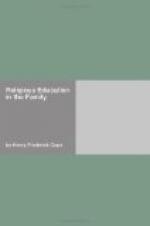This condition gave rise to the public-school system. It appealed to Robert Raikes and others. The school appeared and took over the child. Of course schools had existed, here and there, long before this, but now they had an enlarged responsibility; they must act almost in the place of the parents for the formal training of children. Having lost the father and older males for the greater portion of the day, the home now loses the children of from seven to the “’teen” years for five or six hours of the day. The mother is left at home with the babies. The family, once living under one roof, now is found scattered; it has reached out into factory and school. Its hours of unified life have been markedly reduced.
But the factory system soon had a reflex influence on the home. That which was made in the factory came back into the home, not only in the form of the articles formerly made by the men, but in those made by the women. Clothes, candles, butter, cheese, preserves, and meat—all formerly home products for the use of the family producing them—now were prepared in larger quantities, by mechanical processes, and were brought back into the home. Woman’s labor was lightened; the older girls were liberated from the loom and they began to seek occupation, education, and diversion according to their opportunities in life.
That last step made it possible for people to think of the communization of home industry, to think of eating food cooked in other ovens than their own, to think of one oven large enough for a whole village. Many interesting experiments in co-operative living immediately sprang up. But the next step came slowly and, even now, is only firmly established in the cities, in the actual abandonment of the family kitchen for the community kitchen in the form of the restaurant. In such families we have unity only in the hours of sleep and recreation.
Along with abandonment of the separate kitchen there has proceeded the abandonment of the parlor in the homes of the middle classes. To lose the old, mournful front room may be no subject for tears, but the loss of the evening family group, about the fireside or the reading-lamp, is a real and sad loss. The commercialized amusements have offered greater attractions to vigorous youth. The theater and its lesser satellites, amusements, entertainments, lectures, the lyceum, and recreation-by-proxy in ball games and matches have taken the place of united family recreation. Of course this has been a natural development of the older village play-life and has been by no means an unmixed ill.
Now, behold, what has become of the old-time home life! The family that spent nearly twenty-four hours together now spends a scarce seven or eight, and these are occupied in sleeping! Little wonder that the next step is taken—the abandonment of this remainder, the sleep period, under a domestic roof, as the family moves into a hotel!




